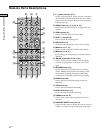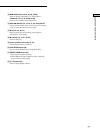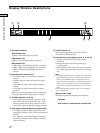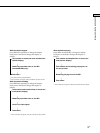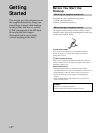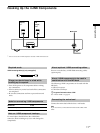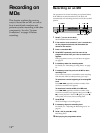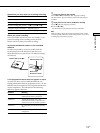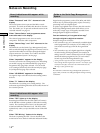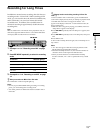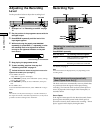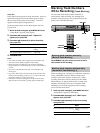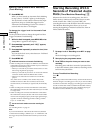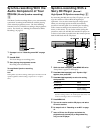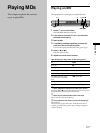
14
GB
Recording on MDs
Notes on Recording
About indications which appear while
recording
When “Protected” and “C11” alternate in the
display
The record-protect slot is open and the MD is record-
protected. To record on the MD, slide the tab to close the
slot. For details, see “To prevent accidental erasure of the
recorded material” on page 13.
When “Cannot Select” and programme source
name alternate in the display
The selected programme source is not an audio
component. Select the audio component.
When “Cannot Copy” and “C12” alternate in the
display
The MD deck uses the Serial Copy Management System.
MDs recorded through the digital input connector can’t be
copied on other MDs or DAT tapes through the digital
output connector. For details, see “Guide to the Serial
Copy Management System” on this page.
When “Impossible” appears in the display
You tried to record over existing track(s) (see “Recording
on an MD” on page 12) while Shuffle Play (page 24) or
Programme Play (page 24) is selected. You can record
over existing material only when the normal play (page
21) or Repeat Play (page 23) is selected.
When “NO SIGNAL” appears in the display
No signal is input to the MD deck and recording cannot
be done.
When “Tr” flashes in the display
The MD deck is recording over existing track(s). The
indication stops flashing when the deck reaches the end of
the recorded portion.
About indications which appear after
recording
When “TOC” lights up in the display
Recording has finished but the TOC (Table of Contents)
on the MD has not been updated to reflect the recording
results. The recording will be lost if you disconnect the
mains lead while the indication is on. The TOC will be
updated only when you eject the MD or turn off the MD
deck.
When “TOC Writing” flashes in the display
The deck is updating the TOC. Do not disconnect the
mains lead or move the deck while the indication flashes.
Guide to the Serial Copy Management
System
Digital audio programme, such as CDs, MDs, and DATs
make it easy to produce high-quality copies of music by
processing music as a digital signal.
To protect copyrighted music sources, this deck uses the
Serial Copy Management System which allows you to
make only a single copy of a digitally recorded source
through digital-to-digital connections.
You can make only a first-generation copy
*
through a digital-to-digital connection.
Examples are given as follows:
• You can make a copy of a commercially available digital
sound programme (for example, a CD or MD), but you
can’t make a second copy from the first-generation
copy.
• You can make a copy of a digital signal from a digitally
recorded analog sound programme (for example, an
analog record or a music cassette tape) or from a digital
satellite broadcast programme, but you can’t make a
second copy from the first-generation copy.
*
A first-generation copy means the first recording of a digital audio
source through the deck’s digital input connector. For example, if you
record from a CD player connected to the i.LINK S200 connector,
that copy is a first-generation copy.
Note
The restrictions of the Serial Copy Management System don’t
apply when you make a recording through the analog-to-analog
connections.



